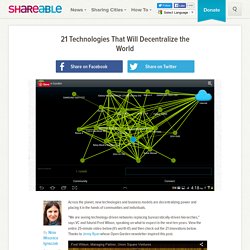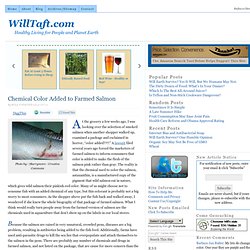

21 Technologies That Will Decentralize the World. Across the planet, new technologies and business models are decentralizing power and placing it in the hands of communities and individuals.

"We are seeing technology-driven networks replacing bureacratically-driven hierarchies," says VC and futurist Fred Wilson, speaking on what to expect in the next ten years. View the entire 25-minute video below (it's worth it!) And then check out the 21 innovations below. Thanks to Jenny Ryan whose Open Garden newsletter inspired this post.
Here are 21 innovations that will help make it happen: 1. Decentralized technology will become mainstream in 2014, according to the Open Garden Foundation, a San Francisco-based startup dedicated to net neutrality and internet access for everyone. 2. Commotion Router is free, open source software that allows for communities to build their own mesh networks. Video pubblicati da Kanti Swami I TRE STADI DELL'AMORE. ( 3^ e ultima parte) Pacific Ocean takes perilous turn. Ocean acidification, the lesser-known twin of climate change, threatens to scramble marine life on a scale almost too big to fathom.

NORMANBY ISLAND, Papua New Guinea — Katharina Fabricius plunged from a dive boat into the Pacific Ocean of tomorrow. She kicked through blue water until she spotted a ceramic tile attached to the bottom of a reef. A year earlier, the ecologist from the Australian Institute of Marine Science had placed this small square near a fissure in the sea floor where gas bubbles up from the earth. She hoped the next generation of baby corals would settle on it and take root.
Fabricius yanked a knife from her ankle holster, unscrewed the plate and pulled it close. Instead of a brilliant new coral reef, what sprouted here resembled a slimy lake bottom. Isolating the cause was easy. Carbon dioxide. In this volcanic region, pure CO2 escapes naturally through cracks in the ocean floor. That makes this isolated splash of coral reef a chilling vision of our future oceans. Reimchen - n15clayoquot.pdf. 8. Working With Not Against Natural Forces - an original permaculture principle. Permaculture, a contraction of permanent agriculture but also increasingly permanent culture, means working with natural forces like the wind, sun, water, the forces of succession, animals and other 'natural' energies.

These permaculture designs provide food, shelter, water and meet other needs required to build sustainable communities with minimum labor and without depleting the land and bioregional, regional, national even global ecosystems. That is the ideal: stability, biodiversity, and the 7th generation principle. It is a vision of a whole culture including agricultural systems that provide for the needs of human beings without damaging the ecosystems in which we live.
The seed thoughts are: abundance, thriving ecologies, biodiversity, stable and peaceful cultures and an understanding of our deep interdependence as a species. Beyond physics? We live in a world full of natural forces or laws but are they purely ones we learn about in our Physics classes at school? Yes and no. Animals. Bad things got worse and good things are lost. Chemical Color Added to Farmed Salmon. Photo by: 7Barrym0re - Creative Commons At the grocery a few weeks ago, I was looking over the selection of smoked salmon when another shopper walked up, examined a package and exclaimed in horror, “color added??!!”

A lawsuit filed several years ago forced the marketers of farmed salmon to inform consumers that color is added to make the flesh of the salmon pink rather than gray. The reality is that the chemical used to color the salmon, astaxanthin, is a manufactured copy of the pigment that wild salmon eat in nature, which gives wild salmon their pinkish-red color. Self-Healing Solar Cells Mimic Plant Leaves to Repair Themselves. Photo via Shutterstock Plant leaves are the ideal model for a lot of solar technology, so it only makes sense that developers of manmade solar panels would look to Mother Nature to improve the efficiency of their designs.

Over time, solar cells wear down — just like leaves — due to degradation caused by ultraviolet light. A team of researchers from North Carolina State University revealed this week that they have created a new type of solar cell that can repair and reinvigorate itself by mimicking the functioning of organic vascular systems found in nature. Biomimicry is a hot topic in the design world these days, especially in the field of solar technology, where researchers are striving to produce solar cells that function as efficiently as plant leaves. For its regenerative solar cell, the NC State team used natural materials that are cheaper and more eco-friendly than the standard silicon-based solar cells.
Via CleanTechnica. Bill Mollison Permaculture Pamphlets. Pamphlet 1 – Introduction to Permaculture Pamphlet 2 – Permaculture in Humid Landscapes Pamphlet 3 – Permaculture in Arid Landscapes Pamphlet 4 – Permaculture on Low and High Islands and PC on Granitic Landscapes Pamphlet 5 – Permaculture for Fire Control and Permaculture for Millionaires Pamphlet 6 – Designing for Permaculture Pamphlet 7 – Permaculture Techniques Pamphlet 8 – Forests in Permaculture Pamphlet 9 – Water in Permaculture Pamphlet 10 – Permaculture in Urban Areas and Urban-Rural Links Pamphlet 11 – The Permaculture Community Pamphlet 12 – The Permaculture Alternative Some quotes from Bill Mollison during a design course in 1982. The World's Most Dangerous Trail on Mr. Huashan Leads to a Teahouse.